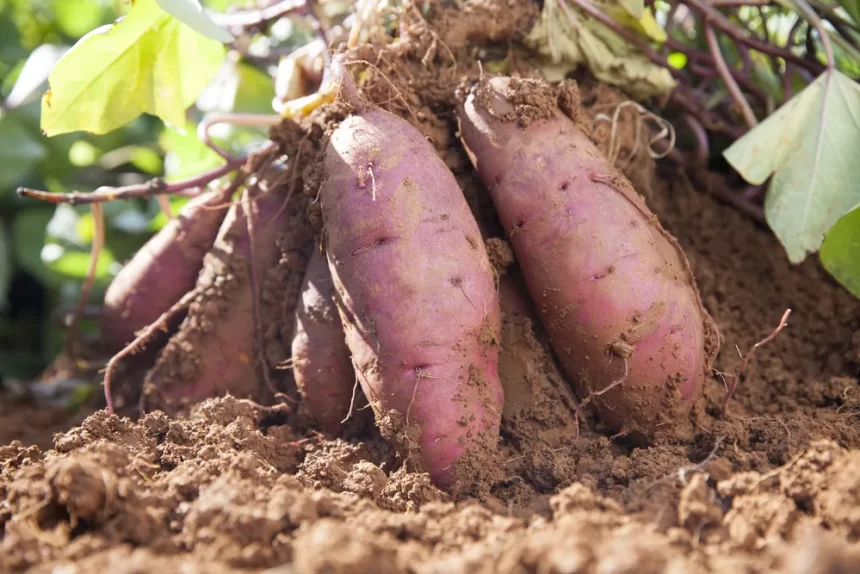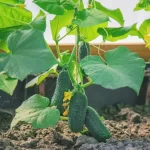I have grown sweet potatoes for many years in my home garden. I originally planted them because I wanted that delicious homegrown sweet potato taste. However, over time I discovered that sweet potatoes can be tricky to cultivate and are susceptible to certain pests and diseases. That’s when I began researching companion planting to help my sweet potato vines thrive.
Why Companion Plant Sweet Potatoes?
While sweet potatoes vine well on their own when given adequate space, water and nutrients, I’ve found that they do even better when planted alongside helpful companion plants. That’s because certain plants help deter common sweet potato pests and diseases, enhance the soil nutrients sweet potatoes need and can even boost their growth and yield.
Some key reasons why you may want to companion plant your sweet potato patch include:
Repel Pests
Sweet potato vines are magnets for certain insects that feed on and damage the leaves, tubers and roots. These include cucumber beetles, wireworms, grubs, aphids, potato flea beetles and sweet potato weevils. Planting pest-repelling companions helps divert these bugs and prevent losses.
Enhance Soil Nutrients
While sweet potatoes aren’t too picky about soil quality, their growth and yield definitely improve in nutrient-rich earth. The long vines need a constant supply of nitrogen during the growing season. Companion plants with deep roots can bring up nutrients from lower soil levels or fix nitrogen from the air into the soil.
Boost Yields
Some companion plants for sweet potatoes seem to enhance their growth and vigour, which translates into higher tuber production by the end of the season. These beneficial companions attract pollinators, suppress competing weeds, retain soil moisture and improve the soil life.
Having grown sweet potato vines both with and without interplanted companion plants for comparison, I’ve observed markedly larger harvests with well-chosen companions lending beneficial effects.
Best Companion Plants to Deter Pests
Here are some great options for plant companions that deter many of the insect pests that attack sweet potato plants.
Marigolds
These brightly flowering annuals are one of my go-to companion plants in the garden. Marigolds contain chemical compounds that naturally repel many common garden pests. The pungent scent released through their roots and decaying plant matter drives away insects and nematodes from their vicinity.
For your sweet potato patch, choose marigold varieties with smaller flowers like Signet or Petite marigolds rather than large-flowered hybrids. Some specific marigold cultivars to try are ‘Tangerine’, ‘Lemon Gem’, ‘Petite Blanche’ and ‘Petite Yellow’.
Plant marigold transplants in between your sweet potato slips soon after you’ve set them out. Over the growing months, the marigolds will blanket the soil to form a repellent understory layer beneath the vining potato plants.
Nasturtium
These ornamental edible flowers also have excellent pest repelling tendencies, protecting many fruits and vegetables from aphids, whiteflies and other attacking insects through their emitted biochemicals.
To grow nasturtium alongside sweet potatoes, sow seeds directly around your transplanted slips or position starter plants. Let the low-trailing or mounding varieties weave through the vining potatoes as they spread. Choosing nasturtiums with brighter blooms seems to boost the protective benefits for neighbouring plants.
Horseradish
The powerful scent given off by horseradish roots repels potato beetles that can ravage sweet potato foliage and tubers. Simply transplant horseradish plant offsets along the sweet potato rows a few weeks after setting out your slips. Make sure to contain their spreading roots by planting inside bottomless buckets buried to ground level.
Horseradish will keep repelling sweet potato bugs and beetles long after both crops have been harvested, so the plants are useful companions for following seasons too.
Companion Plants that Enhance Growth
Here are some excellent plant teammates that actively improve the growing conditions for sweet potato vines, boosting their vigour and lifting yields.
Beans
All types of beans enrich soil with nitrogen, which sweet potato vines need in abundance. The tubers will grow bigger with greater nitrogen availability during their swelling stage.
Bush beans, pole beans and even soybeans are great companions. Include them in wide plantings, in row rotations with sweet potatoes or along border edges surrounding your main patch. Their upright growth won’t compete much with the low-spreading sweet potatoes.
Peas
Like beans, pea plants host special nitrogen-fixing bacteria on their roots which draw this essential nutrient from the air into the soil. This gradually improves fertility around the sweet potato plants.
Choose upright growing peas rather than low-vine varieties. Scatter seeds around newly planted sweet potato slips or establish pea transplants first and interplant the sweet potato slips afterward in the same spaces.
The peas will mature and finish producing before the potato vines start seriously enlarging their tubers, then act as a nutritious mulch.
Radishes
These fast-growing crisp root veggies help in multiple ways as companions for sweet potato plants. Their roots mine nutrients from deep underground, pulling up minerals like phosphorus into upper soil levels where potato feeder roots can access them.
Radishes also improve soil aeration and drainage down the soil column. Plant quick-maturing round or long radishes together with your sweet potato slips. As the radishes bulb up, the emerging vines will shield their heads from sunlight, keeping them tender.
Like peas, the radishes will be ready for pulling once the vines start spreading energetically. Their decaying foliage adds organic matter to feed beneficial soil microbes.
Lettuce / Salad Greens
Shallow-rooted lettuces and salad mixes are perfect useful companions underneath, between and around just-planted sweet potato slips. Not only do they utilize space that would otherwise grow weeds, but the young greens act as living mulch to retain soil moisture and humidity.
Transplant lettuce seedlings soon after setting out sweet potato propagules to gain a head start in growth. Or broadcast lettuce seeds directly around the transplanted slips. Harvest the greens over several successive cuttings before the enlarging potato vines take over that space.
Fixing Nutrient Deficiencies with Companions
Targeted companion planting also helps correct potential nutrient deficiencies that may hamper optimal sweet potato growth and production.
Magnesium Boosters
Plant dandelion, nettle, lambsquarters or chickweed around your slips to increase soil magnesium levels. Their deep taproots mine magnesium from way down the soil column and concentrate it in their foliage and roots. As companion plants decay back into the earth, they release magnesium exactly where active sweet potato feeder roots will exploit those openings.
Calcium Sources
Calcium is essential for prolific development of storage roots and helps prevent internal brown rot in the tubers. Companions that boost available soil calcium include comfrey, lambsquarters, clovers and parsley. Let their residue and gathered fallen leaves decompose near the base of sweet potato plants.
Potassium Accumulators
Vining crops remove lots of potassium from soil over a single growing season. Help replace that by planting dynamic accumulators like dandelions, plantain, nettle, alfalfa or fava beans around your slips. As the companions grow, they efficiently mine potassium from subsoil then shed it via fallen foliage to replenish surface levels.
Planning and Maintaining Your Companion Planted Sweet Potatoes
Interplanting helpful companion plants with your sweet potato slips encourages beneficial interactions underground as well as above soil level. But some planning and extra care is needed to gain the full potential advantages.
Here are key tips:
Be Selective About Varieties
Choose compact, determinate companions that won’t outgrow or smother developing vines. Lettuce, brassicas, aromatic herbs all intermix well. Use care with spreading plants like squash, cucumbers or taller flowers.
Include Blossoming Plants
Attract pollinators by including nectar-rich flowering herbs (oregano, thyme), edible blossoms (nasturtiums, calendula) and bee-attracting hybrids (marigolds, zinnias). More blossom visits translate into better vine fertility and tuber yields.
Use Containers Wisely
Ring the outer margins of your planting with potted companion plants or place pails of nutrient accumulators at intervals among the sweet potatoes. Container plant roots won’t compete but still lend beneficial proximity.
Adjust Densities Carefully
If interplanting seeds, sow just lightly around transplants then thin for balanced spacing. Transplant seedlings at quite wide intervals. Companions planted too densely cause overcrowding issues later on.
Weed and Water Attentively
Companion plants mean more total plants per square foot competing for moisture. So vigilantly remove weeds and irrigate properly to avoid water stress for either crop. Apply several inches of organic mulch after plant establishment.
My Favorite Potato Variety and Companion Plant Combination
Among all the sweet potato varieties I’ve grown, Beauregard has performed exceptionally well and delivered bumper harvests in my regional growing conditions. It yields large tuberous roots with tasty orange flesh.
The companion plants that I’ve found boost Beauregard growth and deter pests most noticeably are:
- Petite Yellow marigolds
- Bright mix nasturtiums
- Pole beans on the perimeter
- Quick-bulb radishes between slips
- Lettuce understory
I prepare raised planting rows in early summer, enriched with rotted manure and vegetable compost. After transplanting Beauregard slips 18 inches apart, I set the marigold and nasturtium starters in between. Then broadcast lettuce and radish seeds nearby. My final flourish is sowing bean seeds around the bed edges and installing trellises.
With this vibrant polyculture design, the Beauregards excel through the hot months. Foliage stays robust and pest free while clusters of tubers swell prolifically underground. It’s a joy harvesting so many beautiful sweet potatoes along with other companion vegetables come autumn. The remaining plant residue also improves my garden soil over winter.
Soil Management and Watering
Here are some tips for soil management and watering when companion planting sweet potatoes:
Soil Management
- Make raised beds for planting. This helps the water drain better and keeps the soil warm, which sweet potatoes like. Mix in compost or old manure before planting.
- Test the soil to see what nutrients and pH it has. Add fertilizer or things to change the pH a few weeks before planting if needed.
- Loosen the soil up to 12 inches deep if you can. Sweet potatoes grow deep roots, so break up any hard or packed soil that might get in the way.
- After planting, put 3-4 inches of mulch like straw, leaves, wood chips, or compost around the plants. This keeps water in, stops weeds, and keeps the soil cool.
- Plant other plants that take nutrients from deep in the soil around the edges or in pots. As they grow, their roots bring minerals up to the top of the soil when their leaves fall. Cut the leaves and spread them around as mulch.
Watering Practices
- Water every week so the soil stays damp (but not too wet) at least 8 inches down where the sweet potatoes are growing.
- Put hoses with holes or drip lines under the mulch to water. This keeps the leaves dry which helps stop diseases.
- Check how wet the soil is by digging down with a trowel. Don’t just check the top, which dries out faster. Water again when the top 4 inches get crumbly.
- Water more often during the hottest part of summer when the vines are growing a lot of leaves and the sweet potatoes are getting bigger.
- Make sure the other plants you planted get enough water too. Plants in pots may need more water. Change how much you water if needed.
- Water less when it’s almost time to pick the sweet potatoes in the fall. Too much water late can make the sweet potatoes rot in the soil.
Final Thoughts
Growing healthy, high-yielding sweet potato crops can be an enjoyable yet challenging endeavor for gardeners. The vining plants need very specific conditions to thrive, including hot temperatures, rich soil and consistent moisture. At the same time, they are magnets for insect pests while susceptible to diseases.
Employing compatible companion planting is one smart organic strategy to maximize success with sweet potato cultivation. Certain flowers, vegetables, herbs and cover crops make excellent plant partners by deterring pests, accumulating soil nutrients, fixing nitrogen, attracting pollination and more.
I hope these tips help you achieve success companion planting with your own sweet potato crops. Let me know if you have any other questions – happy gardening!




